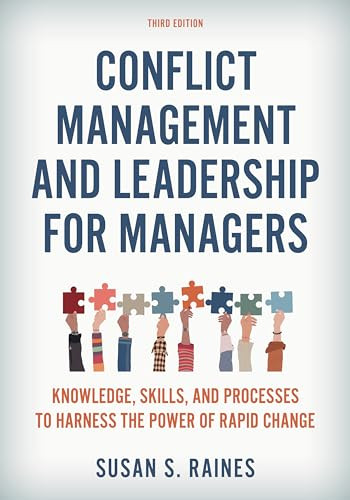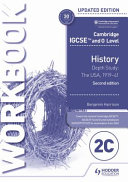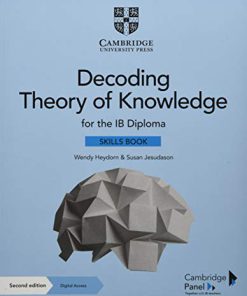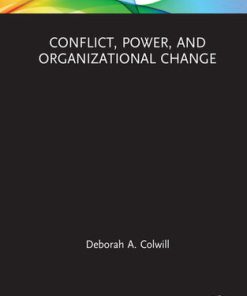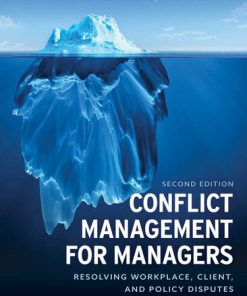Conflict Management and Leadership for Managers: Knowledge, Skills, and Processes to Harness the Power of Rapid Change 3rd Edition by Susan Raines 9781538177983 1538177986
$50.00 Original price was: $50.00.$25.00Current price is: $25.00.
Conflict Management and Leadership for Managers: Knowledge, Skills, and Processes to Harness the Power of Rapid Change 3rd Edition Susan Raines – Ebook Instant Download/Delivery ISBN(s): 9781538177983, 1538177986
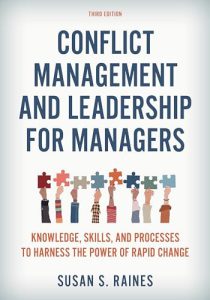
Product details:
- ISBN 10:1538177986
- ISBN 13:9781538177983
- Author: Susan Raines
Conflict Management and Leadership for Managers
Knowledge, Skills, and Processes to Harness the Power of Rapid Change
Table contents:
List of Boxes, Figures, and Tables
Acknowledgments
INTRODUCTION TO THE THIRD EDITION
Reframing the Human-Organization Relationship
About the Author and This Book
A Tale of Two Managers
Meet John, Director of the State Bureau of Reclamation
Meet Elise, Founder and CEO of Main Street Bakeries
How to Use this Book
Public-Sector Managers
Private-Sector Managers
Nonprofit-Sector Managers
Not a Manager Yet?
Organization of the Book
Lessons of the Great Resignation: Generational Differences in Turnover and Workplace Expectations
Calculating the Cost of Conflict: Knowledge Is Power
Conclusion
Key Terms
Discussion Questions
Exercises
Notes
PART I. BASIC CONFLICT MANAGEMENT KNOWLEDGE AND SKILLS
1 MANAGER KNOW THYSELF: THE TRAITS AND BEHAVIORS OF GREAT CONFLICT MANAGERS
Learning Objectives
Responding to Conflict at the Bureau of Reclamation
Traits and Behaviors of High-Performing Managers
Managers and Leaders
What Makes a Great Manager?
Management Styles: Permissive, Authoritative, and Authoritarian
Responding to Conflict: Five Common Approaches
Conflict Avoidance
Accommodation
Collaboration
Compromise
Competition
Choosing between the Conflict Styles
The Language of Conflict
Listening Skills: The Foundation of Conflict Management
Questioning
Emotional Intelligence and Exceptional Managers
Conclusion
John at the Bureau of Reclamation
Key Terms
Discussion Questions
Exercises
Goal Setting
Suggested Supplemental Readings
Note
2 THEORY TO PRACTICE: THE ROOT CAUSES AND CURES OF CONFLICT
Learning Objectives
Elise and Unproductive Conflict at Main Street Bakeries
Issues and Typologies of Workplace Conflict
Uncovering the Causes of Conflict
Levels of Analysis for Organizational Conflicts
Biological, Physiological, and Evolutionary Theories of Conflict and Resolution
The Evolution of Cooperation and Conflict
Intrapersonal (and Intrapsychic) Causes of Conflict
Rupture and Repair: The Bonding Power of Conflict
Trauma Healing and the Role of Managers
Personality-Based Conflict Theories
Psychodynamic Theories of Behavior and Conflict
Personality Disorders and Conflict
In-Group/Out-Group Theory
Cognitive Biases
The Seven Deadly Cognitive Biases of Negotiation
Social Learning Theory
Framing toward a Collaborative Process
Fairness and Procedural Justice
Concepts of Fairness across Cultures
Power in Theory and Practice
The Timing of Conflict Interventions
Systemic versus Nonstructural Sources of Conflict
Predicting and Preventing Workplace Violence: Theories and Practice
Conclusion
Elise and Main Street Bakeries: Ben’s Trip to Store Number 75
Key Terms
Discussion Questions
Exercises
Goal Setting
Suggested Supplemental Readings
3 THE POWER OF NEGOTIATION: ESSENTIAL CONCEPTS AND SKILLS
Learning Objectives
Elise and Main Street Bakeries
Managers as Negotiators
Ninja Negotiation Skills
Distributive versus Integrative Bargaining
Steps in Distributive Bargaining
Steps in Integrative Bargaining
Planning for Your Negotiation
Negotiation Terms and Concepts
Anchoring Number
Asking Price
Target Point
Resistance Point
Impasse and Obstacles to Settlement
Personal Attacks or Offensive Behavior
The Spotlight Is Too Bright
Emotional Investment
Time Pressure
Absent Decision-Maker
Bring in a Third Party
Negotiations to Avoid
Trust Building and Trust Repair in Negotiations
How to Negotiate a Salary Increase
Unconscious Bias in Salary Negotiations
Conclusion
Elise and Main Street Bakeries
Key Terms
Discussion Questions
Exercises
Goal Setting
Suggested Supplemental Readings
4 THE ALTERNATIVE DISPUTE RESOLUTION (ADR) CONTINUUM
Learning Objectives
John at the Bureau of Reclamation
The ADR Continuum
Direct Negotiations
Open-Door Policy
Mediation
Case Evaluation
Peer Review
Arbitration
Adjudication or Court Action
Negotiated Rulemaking
Ombudsman (Ombuds)
Facilitation
Summary Jury Trials
Coaching
Additional Problem-Solving Techniques
Conclusion
John at the Bureau of Reclamation
Key Terms
Discussion Questions
Exercises
Goal Setting
Suggested Supplemental Readings
5 MANAGING ACROSS CULTURES AND GENERATIONS: DEEPER UNDERSTANDING FOR MAXIMAL PERFORMANCE
Learning Objectives
Elise at Main Street Bakeries
Anthropological Hacks to Understand Cultural Difference
Diversity and Conflict
Power, Diversity, and Conflict
Organizational Culture Change: Answering the Question “Who Are We?”
The Globalized Nature of Work in the Twenty-First Century
Conflict, Communication, and Culture
High-Context and Low-Context Cultures
Individualism versus Collectivism
Orientations toward Time
Gender Role Differences across Cultures
Hierarchy versus Equality
Common Causes of Conflict in the Intercultural Workplace
Working Successfully with Multinational Corporations
Working across Generations
Critical Conclusions for the Intercultural Workplace
Elise at Main Street Bakeries in Montreal
Key Terms
Discussion Questions
Exercises
Suggested Supplemental Readings
Note
PART II. THE PREVENTION AND RESOLUTION OF INTERNAL ORGANIZATIONAL CONFLICTS
6 BUILDING HEALTHY ORGANIZATIONAL CULTURES: THE FOUNDATION OF SUCCESS
Learning Objectives
John at the Bureau of Reclamation
Defining and Understanding Organizational Culture
Assessing Organizational Culture
You Can’t Hire Your Way out of a Bad Culture
Overcoming the Obstacles to Culture Change
Changing Organizational Culture
1. Don’t Wait for Someone Else to Make Your Work Life Better
2. Each of Us Shapes the Organizational Culture Every Day
3. Set and Communicate Boundaries Respectfully
4. Negotiate Shared Expectations
5. Use the Power You Do Have
6. Invite Leaders to Join In
7. Communicate Strategically Both Within and Outside the Organization
Coaching for Culture Change
Training for Culture Change
Whistleblowers
Should I Stay or Should I Go Now?
John at the Bureau of Reclamation
Key Terms
Exercises
Goal Setting
Suggested Supplemental Readings
7 INTERPERSONAL DISPUTE RESOLUTION AT WORK: ENHANCING EMPLOYEE ENGAGEMENT AND TEAMWORK
Learning Objectives
Elise at Main Street Bakeries
The Big Quit: Employee Attrition and the New Normal
Why Employees Leave or Stay
Improving Performance Reviews: Building Relationships, Commitment, and Performance
Motivating Employees
Motivating across Generations
Dealing with Difficult Employees
Typology of Difficult People at Work
Identifying and Eradicating Workplace Bullying and Violence
3-Step Problem-Solving (also called 3-Step Conflict Resolution)
Conclusion
High Employee Turnover at Main Street Bakeries
Key Terms
Discussion Questions
Exercises
Goal Setting
Suggested Supplemental Readings
8 LEADERSHIP AMID CHAOTIC CHANGE: NEW TOOLS FOR A TRANSFORMED WORLD
Learning Objectives
John at the Bureau of Reclamation
Applying Strategic Leadership for Career and Organizational Goals
The Skills and Abilities of a Strategic Leader
The Achilles’ Heels of Doomed Leaders
Leadership Models and Conflict
Understanding Corporate Life Cycles
Strategic Leadership for Crisis Prevention and Management
Strategic Planning
Best Practices for Team Building
Consider the Team’s Purpose
Enhancing Communication and Decision-Making in Teams: Keeping Pace with Rapid Change
Teams and Trust
Phases of Teambuilding
Assuring High Performance in Teams
Conflict versus Dysfunction in Teams
Leading Virtual Teams and Hybrid Work Environments
Leader’s Role in Hiring, Layoffs, and Conflict Management
Leader-Led Facilitated Problem-Solving
John at the Bureau of Reclamation
Key Terms
Exercises
Case Study: The Manufacturing Mess
Suggested Supplemental Readings
9 DISPUTE SYSTEM DESIGN AND WORKING WITH UNIONS
Learning Objectives
Elise at Main Street Bakeries
Dispute System Design
1. Sexual Assault Investigations in the U.S. Military
2. Equal Employment Opportunity Commission (EEOC)
3. Grade Appeals, Common University Processes
Begin with the End in Mind
Procedural Justice and Dispute System Design
Power, Rights, and Interests
Values Underlie the Design
DSD Concepts and Practices
Focus on Interests
Provide Low-Cost Processes to Secure Rights
Provide Loopbacks to Interest-Based Procedures
Learn from Each Dispute
Try Low-Cost Processes First
Ensure Organizational Members Have the Skills, Knowledge, and Resources Necessary for Success
Four Stages of Dispute System Design
System Design Phase
Implementation Phase
Aligning Incentives for Effective Dispute Resolution
Evaluation and Diffusion Phase
Sample Private-Sector Dispute System Design
Sample Public-Sector Dispute System Design
The United States Postal Service (USPS) REDRESS® Mediation Program
DSD Unionized Workplaces
Labor-Management Conflict in the United States
Trends in Unionization
Union DSD: Common Steps in the Union Grievance Process
The Evolution of Collaboration in Labor-Management Relations
Becoming a Collaborative Leader in a Non-Collaborative Environment
ADR in the Creation of Collective Bargaining Agreements
Conclusion
Elise at Main Street Bakeries
Key Terms
Exercises
Suggested Supplemental Readings
10 THE OMBUDSMAN AT WORK: COACHING, FACILITATING, TRAINING, AND SHAPING ORGANIZATIONS
Learning Objectives
John at the Bureau of Reclamation
The Work of the Ombudsman
Typology of Ombuds Roles
Who Becomes an Ombuds?
Assessing and Sharing the Organizational Benefits of the Ombuds Office
Standards of Practice for Ombudsmen
Processes Utilized by Ombudsmen
Training for Conflict Prevention and Skill Development
Dispute System Design
Case Study of Dysfunctional Corporate Culture: Wells Fargo
Coaching Tools for the Most Common Workplace Complaints
Coaching Tools: A Quick Download for Managers and Ombuds
Tools for Intake
Conflict Styles Coaching Tool
Perspective Taking
Conflict Stories and Difficult Personalities
Delegation
Life-Balance Wheel Coaching Tool
Framing Feedback Coaching Tool
EPM Feedback Model
Systemic Tools for Ombudsman and Manager
Conclusion
John at the Bureau of Reclamation
Key Terms
Discussion Questions
Exercises
Goal Setting
Suggested Supplemental Readings
PART III. THE PREVENTION AND RESOLUTION OF EXTERNAL ORGANIZATIONAL CONFLICTS
11 PRINCIPLES AND SYSTEMS FOR SUPERIOR CUSTOMER SERVICE AND CUSTOMER RECAPTURE
Learning Objectives
Elise at Main Street Bakeries
Rule #1: A House Divided Will Not Stand
Rule #2: Deliver What You Promise: Quality Products/Services
Rule #3: Improvements Require Monitoring
Rule #4: Create Incentives for Desired Behaviors
Rule #5: Empower Employees to Resolve Disputes at the Lowest Level Possible
Ritz-Carlton: Employee Empowerment for “Delighted” Customers
Rule #6: Avoid a Myopic Focus on New Customers over Existing Ones
Rule #7: Devise, Evaluate, and Revise Systems
Technology and Customer Service
Alternative Dispute Resolution for External Stakeholder (Customers/Clients) Disputes
ADR Clauses in Customer Agreements
Patient Care Advocates: Reducing Formal Complaints in Hospital Settings
Conclusion
Elise at Main Street Bakeries
Key Terms
Exercises
Suggested Supplemental Readings
12 PUBLIC POLICY DECISION-MAKING AND COLLABORATION WITH REGULATORS
Learning Objectives
Elise at Main Street Bakeries
Characteristics of Public Disputes
The Spiral of Unmanaged Conflict
Public Policy Process and Concepts
History of Antagonistic Relationships between Regulatory and Regulated Communities
Environmental Conflict Resolution and Public Policy
Characteristics of Public Disputes
Process Menu Options
Public-Private Partnering: Best Practices
Common Errors in Collaboration: A Cautionary Tale
Mistake One: Asking for Collaboration When You’ve Already Made a Decision
Mistake Two: Not Allowing Enough Time, Space, and Money to Support Collaboration
Mistake Three: Proceeding in the Absence of Key Stakeholders
ADR in the U.S. Federal Sector: Leaders, Laggards, and Trends
U.S. Environmental Protection Agency
Department of Justice
U.S. Department of Education
Technology in ADR
Conclusion
Elise at Main Street Bakeries
Key Terms
Discussion Questions
Exercises
Public Policy Dispute Resolution Process Matching
Goal Setting
Suggested Supplemental Readings
13 FACILITATING MEETINGS AND LARGE-GROUP DECISION-MAKING PROCESSES
Learning Objectives
John at the Bureau of Reclamation
To Meet or Not to Meet, That Is the Question
Public and Large-Group Meeting Disasters
Needs Assessment/Conflict Assessment Stage
Convening Stage
During the Process
Implementation after Agreement
The Role of the Media in Public Disputes
Characteristics of Successful Large-Group Facilitators
Habits of an Effective Facilitator
Choosing among Meeting Formats
People also search:
conflict management and leadership
conflict management and leadership for managers
analysis of conflict management and leadership for organizational change
conflict management and leadership skills
leadership and conflict management ppt
You may also like…
Uncategorized
Uncategorized
Crucial Influence: Leadership Skills to Create Lasting Behavior Change, 3rd Edition Joseph Grenny
Education Studies & Teaching - Studying & Test Preparation
Business & Economics - Responsibility and Business Ethics
Conflict Power and Organizational Change 1st Edition Deborah A Colwill
Children's Books - Geography & Cultures
Business & Economics
Business & Economics
Conflict Power and Organizational Change 1st Edition Deborah A Colwill
Business & Economics - Management & Leadership
Crucial Influence: Leadership Skills to Create Lasting Behavior Change, 3rd Edition Joseph Grenny
Business & Economics

